Maybelle Carter
An Icon to the Icons
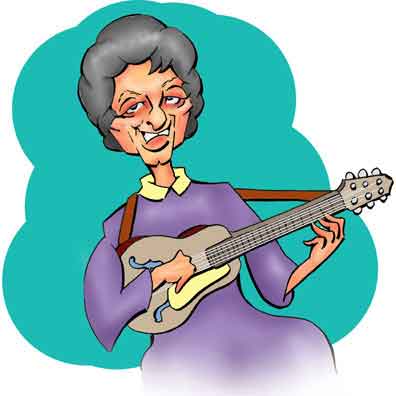
Maybelle Carter
An Icon to ...
Woody Guthrie. Pete Seeger. Doc Watson.
Merle Travis. Chet Atkins. Johnny Cash.
All folk and country music icons.
And Maybelle Carter?
Well, she's an icon, too. But Maybelle is an icon to the icons. Woody, Pete, Doc, Merle, Chet, and Johnny, were all strongly influenced - and we mean strongly influenced - by the music of Maybelle.
Of course, as when dealing with all absolute, immutable, and unchallengable truths, we have to qualify what we just said - or at least qualify what we mean by "icon". Iconicry can be a long time coming. Regardless of his status today, Woody's original records never sold well - five hundred pressings was generous - and except for his early radio program in California (which lasted a year) and Pipe Smoking Time (which was broadcast for barely two months), he did not appear regularly in the media. He was first mentioned in Life Magazine only in 1964 and then in an article about Bob Dylan. So during his lifetime it's difficult to say Woody was a star, much less an icon.
And it's equally incorrect to speak of the Carter Family as if they were the type of mega-country stars that we have today. For one thing, in the early 20th century there were no mega-country stars as we have today. The music - called "hillbilly" music even by its practitioners - simply did not appeal to a widespread audience.
Maybelle Addington was born on May 10, 1909 not far from Nickelsville, Virginia. Nickelsville is tucked down in the southwest region of the state in the Blue Ridge Mountains. The nearest "big city" is probably Kingsport, Tennessee, about fifteen miles to the south-southeast. On the other hand, some may argue for Johnson City, also in the Volunteer State but about twice the distance off.
The always-told story is that Maybelle's older cousin, Sara Dougherty, was sitting in her yard and playing the autoharp and singing when up walked a young traveling salesman named Alvin Pleasant Carter (Alvin sold trees, by the way). He introduced himself and the two began to chat. A. P. (as he was called) was himself a singer and fiddle player who had once been offered a recording contract but had turned the offer down. The couple married in 1915 and they began singing together while Sara also played the guitar, autoharp, and banjo.
Although still in her teens, Maybelle joined the group, and the trio took the name of the Carter Family. The common surname was literally correct since in 1926 Maybelle married A. P.'s brother, Ezra.
Maybelle also played banjo, autoharp, and guitar, and it was on the latter instrument that she found her métier. Although she learned traditional finger-picking, she found she could produce a stronger sound - this was before amplification - by picking the melody on the bass strings with her thumb. But to provide the rhythm, she would brush her fingers across the treble strings, essentially playing both lead and back-up at the same time. Called the "Carter Family Lick" or nowadays the "Carter Family Scratch", the technique was soon adopted by other country musicians.
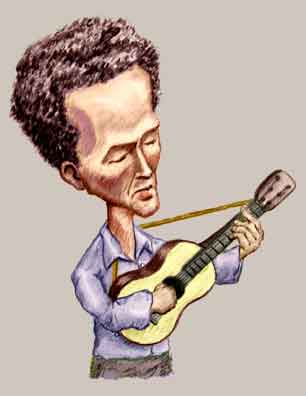
... Woody ...
The usual modus for the group was that Sara sang lead and Maybelle played guitar and sang harmony. A. P. added supplemental and deeper vocal embellishments, and he also assumed the responsibility for managing the group and finding and selecting the songs. Sometimes he would slip in his own compositions as well. The group became a local favorite whenever a church or social function needed music. But bigger times lay just ahead.
You see, the Carter Family had begun singing at just the right time and in the right place. When the new century had come in, if anyone wanted good music, it had to be live music. So you either went to places where the music was played or you played it yourself.
But the first two decades had ushered in a social and technology revolution as monumental as that which began with the penultimate decade of the 20th Century. By the mid-1920's, automobiles had largely replaced horses, commercial airline services were running, and a mass entertainment called radio was reaching the hinterland.
Home entertainment was also undergoing a revolution. By 1925, not only had double sided plastic platters replaced the inconvenient cylinders but a new technology, electric recording, had just burst onto the  scene. Instead of producing tinny, hollow music that sounded like it was from the far end of a two-mile tunnel, recorded sound was now approaching what we now consider modern quality. So you could stay home and hear pretty good music.
scene. Instead of producing tinny, hollow music that sounded like it was from the far end of a two-mile tunnel, recorded sound was now approaching what we now consider modern quality. So you could stay home and hear pretty good music.
The result was a boom for the recording industry so lucrative that the producers and executives actually went scrambling for new groups to record. And that included those playing hillbilly - sorry, that's country music.
There's two stories about how the Carters began recording. One is that A. P. noticed an advertisement that the Victor Talking Machine Company was holding auditions in Bristol, Tennessee. The other story is that A. P. had received a letter from the record producer, Ralph Peer, expressing interest in the group.
In any case, regardless of how they got the news, A. P., Sara, and Maybelle (less than two months away from having the first of her three daughters), on August 1, 1927 all loaded up in a car and drove the twelve-odd miles from their home in Maces Spring, Virginia to Bristol where Ralph had set up a temporary studio.
Twelve miles might not seem like much today but in the days of long and winding roads, the actual driving distance was more like twenty-five. Nor were the roads paved or even graded. Still the story that the drive took them 18 hours might be stretching the blanket. But that the trip was long, hot, and uncomfortable is not to be denied.
But however long the trip took, it was worth it, and they arrived in time to make their first recordings that evening. Ralph liked what he heard and during the first two days of August the Carters recorded six songs. Best of all, they were paid for the session, and the recordings were promptly put up for sale.
To the surprise of everyone, including the Carters and Ralph, the records sold well. The next year the Carters recorded another twelve sides, and in 1929, another two dozen. So if not yet icons, they were stars.
Exactly how many recordings the Carters cut is bedeviled by the number of re-issues and compilations. Another point of confusion is - as we'll see - exactly how you define The Carter Family. Still for the Original Carter Family, the number of songs recorded is usually given at about 300.
That doesn't mean the Carters became rich. We don't know the details of the royalty agreements, but A. P. and Sara's daughter, Janette, said it wasn't much. Record companies were known to be quite creative in how they allotted the royalties. One record producer of folk music, Moses Asch, was notoriously tight-fisted. Dave Van Ronk, one of Moe's recording artists in the 1960's, would sometimes put on a ragged suit and wait until Moe's office was full. Then he'd stagger in and shout, "Moe! You're not paying me!" Moe would go along and say "Why, Dave! I'm glad to see you! I was just about to write you a check!" There was even one pop singer who had signed with a major label and yet was shoveling coal while his group's song was #1 on the charts.
Fortunately money also came in from live appearances which included radio. By necessity the early Carters' professional activity was centered around their homes in southwestern Virginia. But by 1938, their popularity led to a regular radio program on one of the most widely heard radio stations in North America. Ironically this was in Monterrey, Mexico.
The XER "border blaster" stations - XER and XERA - had been set up in Mexico by John "Goat Gland" Brinkley (we will leave "Dr." Brinkley's story for others to tell). Boasting an effective northward broadcasting power of 1,000,000 watts the station could reach a good chunk of the American public. Naturally broadcasting from a foreign country, the stations avoided FCC wattage restrictions. The Carters rented lodgings in Texas and crossed the border to do their show.
After the Carters had spent three years in Texas and Mexico - the Mexican government finally shut the station down - the family returned to their old homes where they played on radio stations in Virginia and Tennessee. Later they appeared on a station in Springfield, Missouri, and finally in the 1940's, they landed a spot on the #1 country music show, the Grand Ole Opry.
For all the bouquets thrown to the Carter Family, today's popular audiences listen to the Carters and snort "These are the models for generations of folk and country musicians?" But rather than go into spittle-flinging diatribes about snooty city-folks, we must cut the modern critics a bit of slack.
Certainly, you aren't going to hear lightning-paced scale passages and flashy arpeggios that have become de rigueur in country music today. Instead Appalachian style music was played at sedate tempos and even hoe downs were rendered at moderate toe-tapping velocities.
And not to disparage the talents of Sara, but she did sing in what we can call a traditional mountain style. To contemporary ears, this often sounds harsh, and we have to admit that there are times where her intonation wasn't quite up to modern standards.
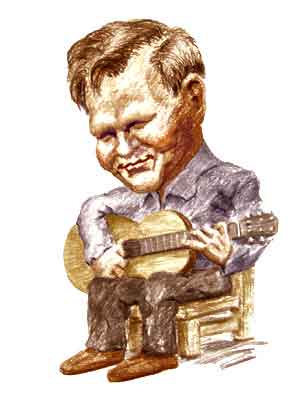
... Doc ...
We don't know the details but eventually the marriage of A. P. and Sara soured. She remarried to A. P.'s cousin, Coy Bayes. and they moved to California. But she continued to perform with Maybelle and A. P., and their last performance as a trio was in 1953. A. P. died seven years later at age 68.
But by then the Carter Family had moved on to phase two. And that was because of yet another revolution - if you want to call it that.
Television had been around literally since the late 1920's but had made no real impact on culture until around 1950. That's when ordinary people began to buy sets for their homes.
A lot of television shows were simply exported from radio: Dragnet, Superman, The Lone Ranger, even Groucho Marx's You Bet Your Life made the transition with success. However, the country music shows were still targeting a niche market. The television's initial try at the Grand Ole Opry in 1955 only lasted two seasons. Ironically, the Ozark Jubilee, virtually unknown to the public today (including many country music fans), ran longer, from 1955 to 1960. The Grand Ole Opry really didn't become popular on television until the 1985 relaunch and after country music had become mainstream.
As far as we know, A. P. never appeared on television, although Sara occasionally performed on the tube singing duets with Maybelle. But the more curmudgeonly of critics will maintain that the really good Carter Family music only began when Maybelle began performing with her daughters and on television.

... Pete ...
Maybelle's kids - Anita, Helen, and June - were quite young when they began singing with A. P., Sara, and their mom. The girls performed regularly on XERA, as did Janette. Janette, though, was never was really part of what became known as the Carter Sisters.
Naturally the girls had learned their music from the adults around them, and at first they sang in the Appalachian tradition as well. But as they grew up, the girls progressed to a more popular style.
Musicologists have pointed out that the singing of musically accomplished siblings produces overtones that are particularly harmonious. That's certainly true for the young Carters. When the girls grew into their teens and early twenties, you could also hear the influence of "sister acts" which arose from the big band era: The Andrews, The McGuires, The Boswells. And as blasphemous as this sounds, once the sisters began appearing on country music shows, what they sang was often not country music.
The Carters - now often billed as "Mother" Maybelle and the Carter Sisters - became a major part of the 1960's country and western scene when they signed on as part of Johnny Cash's tours. This later incarnation of the Carter Family also became regulars on the Grand Ole Opry.
Whether you like their early songs or not, no one denies the influence of the Original Carters. Doc Watson said he listened to the Carter Family as a kid and he adapted a number of their songs to his style. Chet Atkins was not only influenced by the Carters but he gained his fame as a virtuoso guitarist while accompanying Maybelle and the Sisters.
Probably the most direct and unvarnished adapter of the Original Carters' style was Woody Guthrie (Maybelle, we must admit, was the better guitarist). In fact, some songs nowadays usually credited to Woody were Carter Family originals. The Worried Man Blues - nowadays seen as quintessential Woody Guthrie - was released by the Carters in 1927 when Woody was 15 years old. Their style and playing and Woody's are very nearly identical.
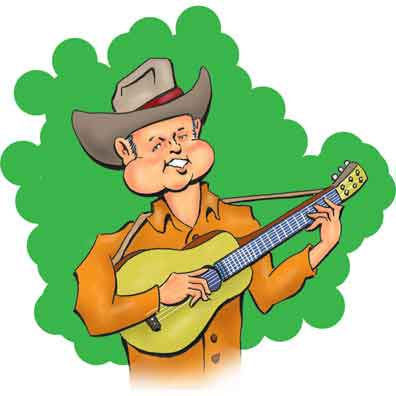
... Merle ...
One song of the Carters and its influence on Woody is worthy of particular comment. That's "Little Darlin' Pal of Mine" which was also in Woody's repertoire.
In later years, the sisters would point out that Woody liked the tune so much that he borrowed it for "This Land Is Your Land". On the surface they were speaking with pride and were pointing out what the Carter's legacy had wrought. But we wonder if they weren't just a little bit irritated since Woody's song was by then far better known than anything the Carters had ever sung.
Now Woody's - ah - "borrowing" of tunes and putting in new words is nothing new. Indeed, a lot of folk composers do the same thing. But "Little Darlin', Pal of Mine" was an original composition by A. P. and copyrighted in 1928. So shouldn't Woody have paid royalties to A. P.?
Although the definitive answer would require consultation with an intellectual property lawyer - and you probably wouldn't get a straight answer even then - in all probability the answer is no. Although there are similarities in the two songs, the actual melodies are noticeably different as you can hear from the brief excerpts below:
Little Darlin', Pal of Mine
This Land Is Your Land
But there's even more reason why Woody's probably OK. That's because the tune was probably not taken from "Little Darlin'". Instead the melody of "This Land" is much closer to - virtually identical to, in fact - that of a traditional hymn. This is (among other titles) "O My Loving Brother" which the Carter's also recorded as "When World's On Fire".
O My Loving Brother/When the World's On Fire
Now we really don't know if the Carter Sisters were irritated with Woody or not. But there was a time when a folk singer vehemently vented against another writer for using "his" tune. In the early 1960's Bob Dylan - Nobel Laureate Robert Zimmerman we should say - wrote the anti-war song "With God On Our Side" only to have the Irish playwright and singer Dominic Behan say Bob had snitched the tune from Dominic's own composition "The Patriot Game". This time Dominic really did seem miffed.
However, this seems to be a case of the pot calling the kettle round. Dominic - knowingly or not - himself had used a tune from an older folk melody. Most scholars list the source variously as "The Merry Month of May", "The Maid and the Grenadier", or "The Nightingale Sings". The tune even crossed the Atlantic as you'll hear if you listen to "The Cowboy and the Lady" by the Bunkhouse Orchestra (also known as the Deseret String Band). This traditional song should not be confused with the more modern and unrelated composition of the same name by John Deutschendorf.
As a soloist Maybelle also got caught up in the folk music revival of the 60's and appeared at the Newport Festivals. In 1970 the Original Carter Family was inducted into the Country Music Hall of Fame. Ezra died in 1975 and Mother Maybelle in 1979.
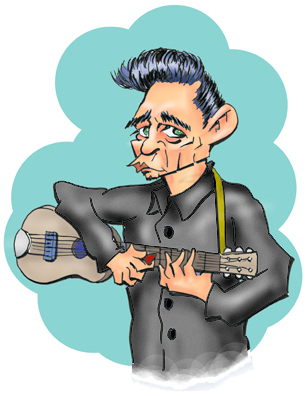
... and Johnny.
(Also a Fishing Buddy
By then, of course, the girls had embarked on their separate careers. The most famous of the sisters was June. Called the "ornery one" (by sister Helen), June married Johnny Cash in 1968 (it was his second marriage, her third). But it was Maybelle, Johnny said, who always been his favorite fishing buddy.
For all the recordings Maybelle made, one of the most notable was one of her last. This was on the Nitty Gritty Dirt Band's unusual album Will the Circle Be Unbroken. The record featured other famous - nay, iconic country singers and musicians - Roy Acuff, Merle Travis, Doc Watson, Vassar Clements - and it was a hit.
With the release of the album in 1972, it finally became OK to be a young denizen of the counterculture - they were called "hippies" back then - and also to enjoy country music. So nearly half a century after the release of the first Carter recordings, you could walk along on campus and hear Maybelle's "Wildwood Flower" wafting from the dorm windows.
References
"The Carter Family", Kristen Bagglelaar Kreps, Folk Music: More Than a Song, Thomas Crowell Company, 1976.
"The Carter Family", Southern Music in the 20th Century, southermusic.net.
"Maybelle Carter", Encyclopedia Britannica.
"A.P. Carter, Guitarist (1891-1960)", Biography.
Mother Maybelle Carter, Columbia Broadcasting System, 1973, Album, Discogs.
"9 Things We Learned from the Carter Family Documentary", David Chiu, Rolling Stone, August 6, 2014.
Smash Hits: The 100 Songs That Defined America, James E. Perone, ABC-CLIO, 2016.
"Sara Carter (1898-1979)", Kip Lornell, Dictionary of Virginia Biography.
"The Carter Family in Del Rio", Doug Braudaway, Val Verde County Historical Commission.
Carter Family - A Comprehensive Discography, Mike Taylor, Hank Williams Discography, 2012 - 2013.
Carter Family, Discography of American Historical Recordings, University of California at Santa Barbara Library.
"Janette Carter Keeps Family's Spirit Alive", Richard Harrington, Washington Post, June 27, 2003.
"The Carter Family", David Vinopal, All Music.
Mother Maybelle Carter's Carter Scratch, Helen Carter (Narrator, Host), Anita Carter (Narrator, Presenter), June Carter Cash (Narrator, Presenter), Johnny Cash (Narrator, Host), Greg Mogford (Director), Mebcon Production, Documentary, 1990.
"The Cowboy and the Lady/Washington's March", Bunkhouse Orchestra Deseret String Band (Hal Cannon, solo vocal), The Round Up, Okehdokee Records, 1999.
"Forebears: Maybelle Carter, The Mother Of Popular Country Music", Liz Tracy, Turning the Tables, National Public Radio, November 17, 2017.
Border Radio: Quacks, Yodelers, Pitchmen, Psychics, and Other Amazing Broadcasters of the American Airwaves, Gene Fowler and Bill Crawford, University of Texas Press, 2002.
"Who Owns the Copyright to 'This Land Is Your Land'? It May Be You and Me", Nira Choski, The New York Times, June 17, 2016.
"Details of 'Happy Birthday' Copyright Settlement Revealed", Ben Sisario, The New York Times, Feb. 9, 2016.
"'Happy Birthday' Copyright Invalidated by Judge", Ben Sisario, The New York Times, September 22, 2015
The Workers' Road to Independence, Constitution Education League, 1944.
Carter Family on Border Radio - 1939, Volumes 1 - 3, Arhoolie Records, Smithsonian Folkways, 1995.
"Rock of Ages", John Work (editor), American Negro Songs and Spirituals, p. 60, Bonana Books, 1940.
"Woody Guthrie: America's Folksinger", Karen Mueller Coombs, Carolrhoda Books, 2002.
"Looking back at the Ozark Jubilee", Kaitlyn, Ozarks Alive, March 19, 2017.
"The Grand Ole Opry (1955-1956)/(1985-2015)" Internet Music Data Base.